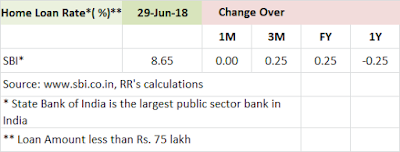The MPC chose to raise the repo rate to 6.25% from 6%, but reaffirmed its neutral policy stance.
While there is no change in the growth rate for 2018-19 at 7.4%, a pick-up from last year's 6.7%, the projection for inflation has risen to 4.7% from 4.4% (made at the April MPC statement).
To my mind, RBI's neutral policy stance needs elaboration as it is difficult to associate a rise in the repo rate and a commentary full of warnings of rising inflation with such a stance.
My own view has been that monetary policy
had already tightened for some time now - the one year treasury bill rate has risen from 6.06% in September 2017 to 7.07% in May this year, the last month -end number before the RBI's MPC statement on June 6, 2018. Likewise, the 10 year treasury bill rate rose from 6.67% to 7.83% in May, 2018. Both represent very significant tightening in money market and bond market conditions.
Much of this tightening was largely instigated willy-nilly by the RBI by its change in policy stance to neutral in February last year. Surely, the RBI's objective under a neutral stance was not to send the treasury bill rate up significantly.
The real rate at above 2% (7% treasury bill rate less CPI inflation at 4.87% for May,2018 or projected inflation at 4.7% by end 2018-19) is unusually high at this stage of India's growth path, when the economy is expected to recover in 2018-19 after two years of slowing growth.
Moreover, as I have repeatedly said the scale of bad loans of the banking sector - roughly about 10% - is really similar to the Great Financial Crash that enveloped the developed world in 2008. In such a situation, we need to
keep real rates at neutral or lower than normal, just like the developed world did - in fact they kept them negative, and continue to be so.
So, while it is comforting that RBI has held its neutral stance, I do not feel there was a need to raise the repo rate - once again the RBI is giving a a signal to banks to raise rates, and giving a signal to capital markets to also do so.
There is no doubt that inflation has been trending up. But whether this a case of a return to normalcy as a result of the slowdown in the economy in the last two years or something structural is not clear at all. One thing that appears apparent is that the sharp fall in inflation coincided with the post-demonetisation phase, just as the recent rise in inflation has coincided with the projected return to normalcy of the economy.


















